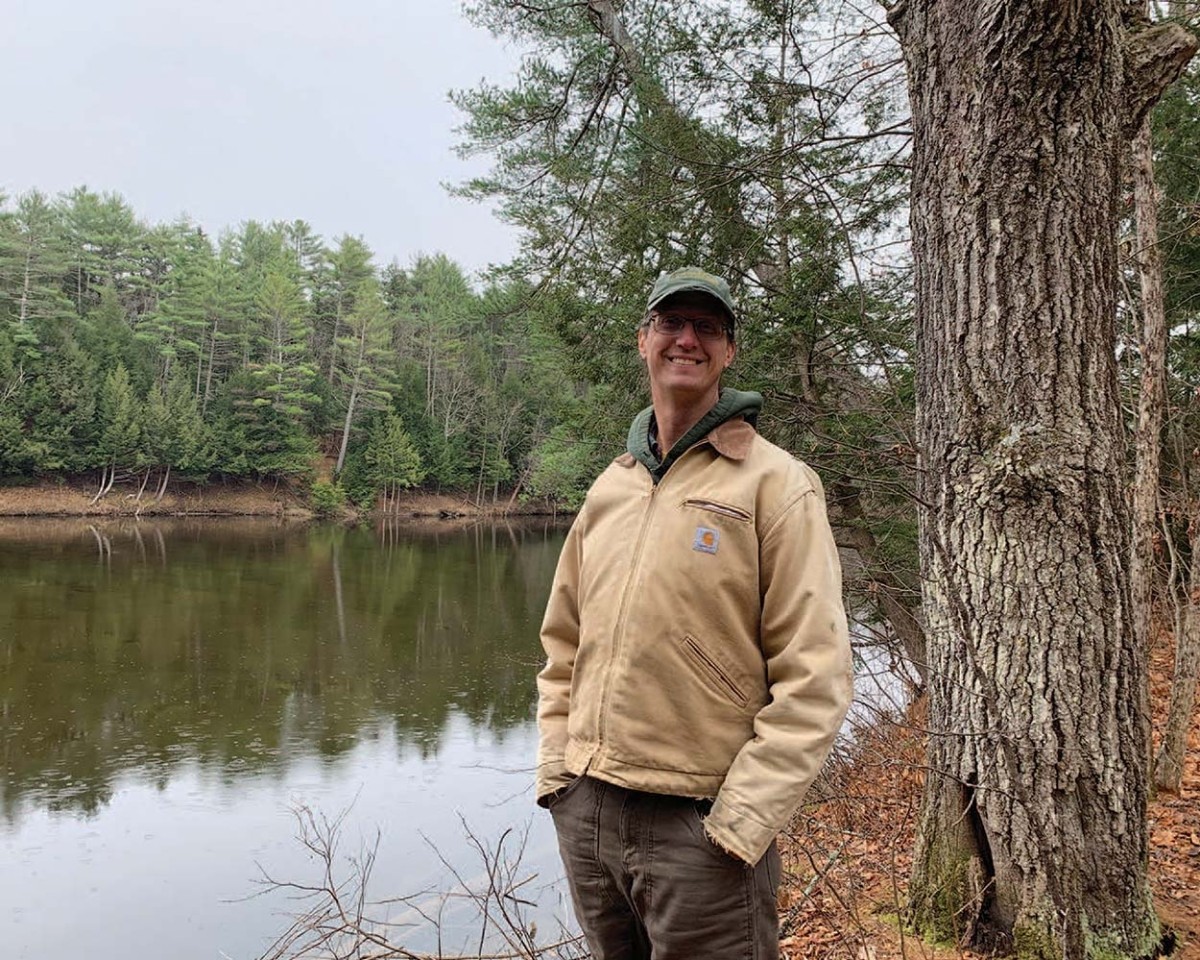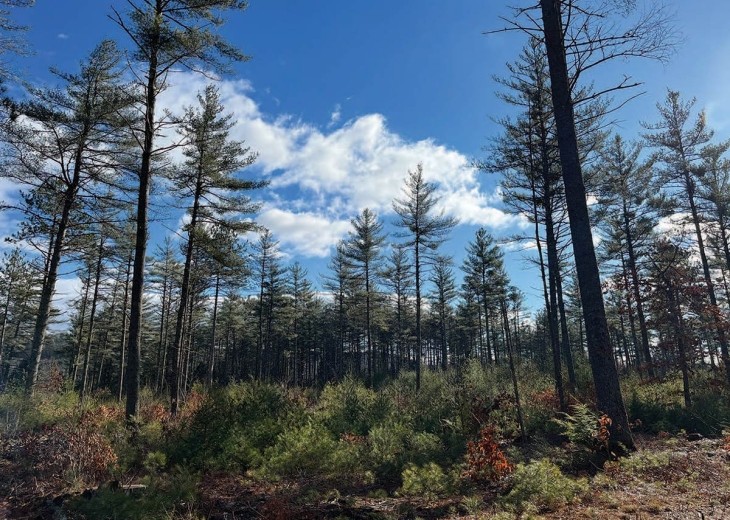On the Martin Family Tree Farm in Bridgewater, New Hampshire, around the time the hardwoods begin leafing out and the bluebirds return to their nesting boxes, the frog chorus begins. On a spring evening, the amphibians call from two vernal pools not far from the Colonial-style house, built from wood harvested from this land. In the field behind the house, male woodcocks whistle and spin through the air in their elaborate courtship dance. Behind the field, a long, wooded ridge rises, and across the road, the Pemigewasset River flows, swollen with recent snowmelt.
“Sometimes I still pinch myself that this is mine,” said Jon Martin, who purchased this 248-acre woodlot in 2007 and now lives on the property with wife Erin Marlowe, their school-age children Nora and Ian, and a menagerie of animals that includes two English shepherds, a couple of goats, a half dozen sheep, and a small flock of laying hens. In 2020, the New Hampshire Tree Farm Committee named this the Outstanding Tree Farm of the Year.
Martin has a longstanding passion for trees and rural land. He grew up in Bristol, just down the road, and graduated from the University of New Hampshire’s Thompson School of Forestry in 1998 and the four-year school at UNH a year later, then went to work as a forester. He founded Martin Forestry Consulting LLC in 2011 and manages about 10,000 acres for clients – ranging from 50-acre properties to a 2,000-acre parcel.
“I love my job so much,” Martin said. “It’s my hobby, it’s my love, it’s what I do in my off time. When I’m working, I’m working for somebody else. And when I’m not working, I’m here tinkering around on the place.”
“The place,” which Martin purchased from David Roberts, spans both sides of River Road along the Pemigewasset. The property comprises a 35-acre pine flat atop sandy riverbed soil; a small, yet-to-be-tapped sugarbush; a robust population of white and red oak; and areas of mixed northern hardwoods and hemlock.
It’s the kind of timber stand Martin never dreamed of owning – until Roberts decided he should.
“I did some tree work for Dave, and he and I just hit it off and became good friends,” said Martin. “During a conversation, it came up that he wanted to sell the property to somebody who would care for it in the same way he did, and I jokingly said that I’d love to own a piece of property like this. We both laughed it off and went our separate ways.”
But the seed had been planted, so to speak, and not long after that conversation, Roberts pitched a sale of the land to Martin and agreed to finance that sale. Martin promised to pursue a conservation easement of the property, they shook hands, and Martin found himself the owner of his own woodlot.
Martin and Marlowe were married at the property’s height of land, overlooking the Sandwich Mountain Range. In 2017, they built a house within the 7-acre patch cut Martin cleared during a timber sale soon after he purchased the land. The house comprises wood primarily harvested from this land. Some 22,000 board feet of white pine went into the walls and beams. The upstairs floors are beech, which Martin said “is spalted a little bit, so it’s really got some personality.” There’s oak in Erin’s office, cherry (from a client’s property) in the stair treads, and the living room floors are made of ash, which Martin said he “wanted to memorialize” before the inevitable arrival of the emerald ash borer.
The property beyond the house is part professional workshop, part carefully considered wildlife habitat, and part playground. Martin has planted the field behind the house – the one where the woodcock dance in spring – in native warm-season grasses, whose deep taproots are well adapted to the dry soil. The sheep graze here during the summer, and several bluebird boxes line the edge of the field.

Two brooks running through the property helped Martin keep his promise of placing a conservation easement on the land. In 2009, he sold an easement on 233 of the 248 acres – retaining two existing house lots and a couple of reserved outages in case Nora and Ian would like houses here in the future – to the Society for the Protection of New Hampshire Forests. A National Oceanic and Atmospheric Administration grant funded the easement, with a goal of protecting anadromous fish migration habitat, Martin said, specifically for Atlantic salmon.
“My goal is to provide a sustainable timber resource that is climate resilient and supports the greatest variety of wildlife habitat that we can,” he said. That includes some commercial timber harvesting, as well as small thinnings to harvest firewood.
Martin is intimately familiar with the landscape of his woodlot and makes management adjustments as needed. When, for instance, he noticed the white pines in one stand didn’t seem to be growing much, he hired a cut-to-length logger to harvest some of the larger trees this past summer, allowing more growth-inducing sunlight to reach the younger pines. He’s also willing to shift course as needed. A decade ago, he did a shelterwood treatment on another stand, hoping to regenerate oak. While the oak didn’t respond as he’d planned, the stand is thriving, with various other hardwood species, along with pine and hemlock.
“I’ve been trying to mix up the diversity. A lot of this property was frequently and lightly thinned over the last 40 years, and it just kept coming back to beech and hemlock persistently,” Martin said. “I’m always telling my landowners to mix it up, do patch cuts, do other treatments – and I looked at my own woodlot and realized I was just growing beech and hemlock.”
His effort to stem an overabundance of beech has included cutting that species in May and June to stunt regrowth in one area, which now features lots of aspen. A close look at the young aspen trees – which mingle with blackberry brambles – shows they’ve been browsed by deer and moose.
“I’m excited to see the aspen. It’s good for wildlife,” Martin said. Beyond deer and moose, the family regularly sees porcupines, turkeys, bears, and – among their favorite neighbors – raptors, including red-tailed and broad-winged hawks.
As most any forest steward will tell you, battling invasives comes with the territory. For Martin, that challenge has involved buckthorn growing throughout an abandoned beaver meadow. Initial attempts to control the buckthorn mechanically proved futile, so Martin has been treating it with herbicides.
He has also been nurturing a modest sugarbush, using small equipment to harvest “junk” and to create space around the sugar maples there. “This is the start of my sugarbush,” he said. “I’m very excited about it. I’m going to give it a couple of more years before we tap it.”
Stewarding the land is a labor of love for Martin. As time allows, he’s been working to establish a network of recreational trails, with an eye toward creating a 5-kilometer loop – and the ability to cross-country ski out the back door.
“It’s fun having your own woodlot,” Martin said. “You get to experiment and try new things – and see what happens.”



